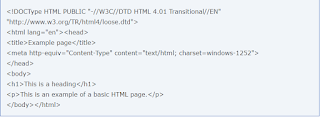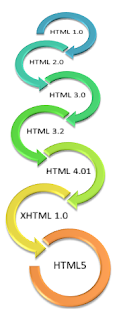Hey guys!
Today, I wanna share a little bit about HTML . Alright , let's start now !
WHAT IS HTML ?
- HTML is short for HyperText Markup Language
- First developed by Tim Berners-Lee in 1990
- HTML is used to create electronic documents(called pages) that are displayed on the WWW(World Wide Web).
WHAT DOES HTML LOOK LIKE ?
FIGURE 1
Figure 1 is an example of a basic web page that written in HTML .
- The first line (DOCType) : what version of HTML the page was written in so that an Internet browser can interpret the text that follows.
- Next, the HTML opening tag : lets the browser know what it is reading HTML code.
- HTML tag is followed by head section : contains information about the page such as its title, meta tags , and where to locate the CSS file.
- The body section : all content that is viewable on the browser.
- Closing tags : wrap each element for proper syntax.
EVOLUTION OF HTML
FIGURE 2
Figure 2 above shows the release of HTML to the world from the first version until the latest version of HTML.
- The World Wide Web was built on good old HTML, the Hypertext Markup Language, which was born out of SGML, the Standard Generalized Markup Language, which dates all the way back to 1986.
- XML, the eXtensible Markup Language, was also born out of SGML. XML caught on so well that it became a standard for sharing data across all kinds of documents and systems.
- The popularity of XML led to the evolution of HTML to XHTML. Essentially, XHTML is a more restrictive subset of SGML, one that can be read better by XML parsers because it follows the rules strictly. If you can picture the typical “odd couple,” HTML is the sloppy roommate and XHTML keeps the contents of the medicine cabinet in alphabetical order.
- HTML5 isn’t as strict as XHTML, but it has some grown-up features, such as better ways to present multimedia.
- HTML5 benefits from two new additions — CSS3 and JavaScript. Combine the power of all three of these current web standards and you can add a lot more interactivity, animation, and even location awareness — features that are especially exciting in the mobile world.

